Click on the link below to download the October 21, 2015 syəcəb
October 21 2015 syəcəb
syəcəb
Source: Northwest Treaty Tribes
Once again denying tribal treaty-reserved fishing rights – and the many federal court rulings that have consistently upheld those rights – the state of Washington is appealing its latest defeat in a case brought by western Washington tribes in 2001 to force repair of hundreds of salmon-blocking culverts under state roads.
Oral arguments for the appeal will be heard tomorrow, October 16 in the Ninth Circuit Court of Appeals in Seattle. The appeal stems from a 2013 ruling by Judge Ricardo Martinez, who issued a permanent injunction requiring the state to repair more than 800 state-owned fish-blocking culverts over the next 15 years. Also at issue is a 2007 decision in favor of the tribes in which Martinez ruled the state’s obligation to fix culverts stems from the treaty right to take fish. The tribes, state, and federal government tried for several years to settle the case, but were unable to reach agreement.
“Our treaty-reserved right to harvest salmon includes the right to have those salmon protected so that they are available for harvest, not only by the tribes, but by everyone,” said Lorraine Loomis, chair of the Northwest Indian Fisheries Commission. “Our treaty rights are at risk because we are losing salmon habitat faster than it can be restored. Without habitat, we have no fish. If we have no fish, we have lost our treaty right, and our culture and economies will be destroyed.”
Tribes reserved the right to harvest salmon in treaties with the United States government more than 150 years ago, in exchange for which the tribes ceded the vast majority of their homeland to allow non-Indian settlement. The treaty fishing right was upheld in U.S. v. Washington, the 1974 ruling that recognized the tribal right to half of the harvestable salmon returning to state waters and established the tribes as co-managers of the resource with the state.
In great part due to loss of habitat, salmon populations have rapidly and continually declined for the past several decades. As a result, both Indian and non-Indian fishermen have suffered from greatly reduced harvests. “We all stand to lose if we cannot protect the salmon’s habitat,” said Loomis. “We were disappointed by the state’s choice to appeal the district court’s decision, especially when restoring salmon benefits Indians and non-Indians alike.”
Blocking culverts deny salmon access to over a thousand miles of good habitat in western Washington streams, affecting the fish in all stages of their life cycle and reducing the number of adult salmon returning to the state by hundreds of thousands of fish. State agencies have consistently told the Legislature that fixing problem culverts is a scientifically sound, cost effective method for increasing natural salmon production. Even so, the state’s sluggish rate of culvert repair meant it would have taken more than 100 years to fix known blocking culverts even as salmon populations continued to decline throughout western Washington.
The injunction forces the state to accelerate the pace of repairs to blocking culverts. Over the past two years, the state agencies have been cooperative in working with the tribes, Loomis said. The Washington Department of Fish and Wildlife, State Parks and Department of Natural Resources have made good progress toward correcting the existing fish blocking culverts, which the injunction requires be fixed by next year. The Washington Department of Transportation is responsible for the majority of failing culverts, which the injunction requires be corrected by 2030. WSDOT’s correction rate is still far too slow, but the Tribes are encouraged by the agency’s recent efforts to re-prioritize funding to bolster culvert corrections and the state Legislature’s increased funding to the agency. Repairs will be funded through the state’s separate transportation budget and will not come at the expense of education or other social services.
The 20 treaty Indian tribes in western Washington always prefer to collaborate rather than litigate to restore and protect salmon and their habitat, Loomis said. “But the state’s unwillingness to work together and solve the problems of these salmon-blocking culverts in a timely manner left us with no alternative except the courts. We hope the Ninth Circuit will fully uphold the district court ruling and that we can move beyond litigation to work cooperatively with the State to protect the salmon resource,” she said.
File Name: Conditional Use Permit Application for one freestanding sign with a height of 35 feet for the Roy Robinson Subaru car dealership.
File Number: CU 2015-001.
Project Description: The proposal is to relocate the existing 25.9 foot Subaru freestanding sign from the Roy Robinson Chevrolet lot located at 6616 35th Ave NE and erect it at the new Roy Robinson Subaru lot while also extending its height to 35 feet. Tulalip Tribal Codes require a conditional use permit approval for freestanding signs exceeding the 16 foot height limitation.
Project Location: Roy Robinson Subaru, 6001 33RD AVE NE, Tulalip, WA 98271
Public Hearing: The Tulalip Tribes Planning Commission hearing will be held on Wednesday, November 4, 2015 at 6:00 P.M. at the Tulalip Administration Building, Room 263, 6406 Marine Drive NW, Tulalip, WA 98271.
Comment Period: Written comments will be presented at public hearing if received by 4:00P.M. Wednesday, November 4, 2015. Verbal comments are welcome at the public hearing.
Contact Person: Orlando Raez, Associate Planner II, Tel. (360) 716-4219; email: oraez@tulaliptribes-nsn.gov, The Tulalip Tribes, Community Development Department, 6406 Marine Drive NW, Tulalip, WA 98271-9694.
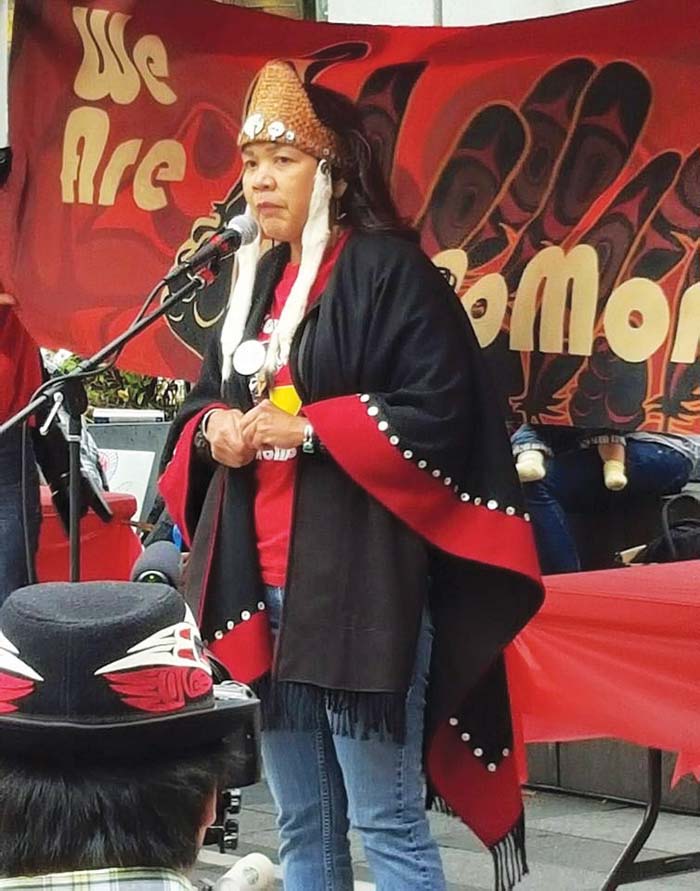
By Micheal Rios, Tulalip News
Congress made the second Monday of October a federal holiday honoring Christopher Columbus in 1937. To all Indigenous, Native, and Fist Nations people, the commemoration of the man responsible for initiating the European colonization of the Americas, which led to hundreds of years of disease, colonial rule and genocidal extermination following the Italian explorer’s accidental trip to the Americas, is just another reminder of the ‘social silence’ we have had to endure as a culture.
‘Social silence’ is the anthropological term for a phenomenon that occurs in a human society when the subjects that are core to how the society function are exactly the ones that are never mentioned. Because European colonialism of the Americas and the mass genocide of millions of indigenous peoples led to the development of the United States (the beacon of hope, prosperity and freedom of the civilized world), there continues to be ‘social silence’ around the cruel and violent history of the United States, of colonialism, and of one Christopher Columbus.
If we maintain the social silence around colonialism, our past and present will always be bewildering. But if we break the silence, and talk about what truly matters, the confusing swirl of struggle and conflict can suddenly make sense. We become silent no more. We become Idle No More.
Last year, the Seattle City Council unanimously voted to change the federal Columbus Day holiday to Indigenous Peoples’ Day, making it the second major U.S. city after Minneapolis to adopt the change. The holiday’s new designation follows a decades-long push by Native American activists in the Coast Salish area to abolish Columbus Day.
Seattle’s decision garnered national media attention and, since then, major cities along the west coast, including Anchorage, Alaska, Portland, Oregon, Albuquerque, New Mexico, and San Fernando, California, have passed legislation changing Columbus Day to Indigenous Peoples’ Days. Only days ago, Alaska Governor Bill Walker signed a momentous proclamation declaring the second Monday of October to be Indigenous Peoples’ Day. While the state of Alaska is the first to rename the federal holiday, credit must be given to South Dakota, the first state to rename the federal holiday as Native American Day in 1990.
So it was with great pleasure and pride that the Daybreak Star Indian Cultural Center, in partnership with Indigenous Peoples’ Day resolution author Matt Remle, held an all-day celebration in Seattle on the 1st anniversary of Indigenous Peoples’ Day on Monday, October 12.
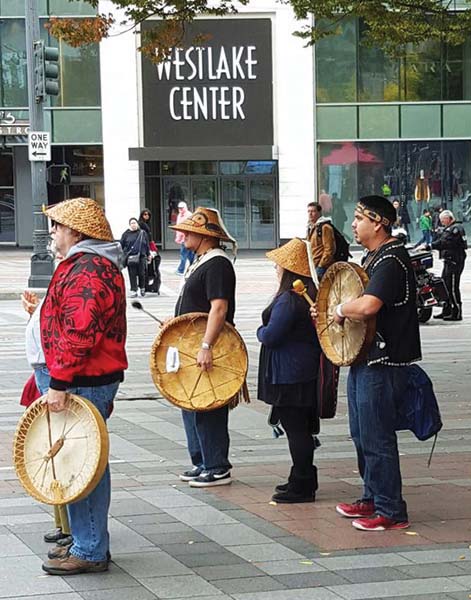
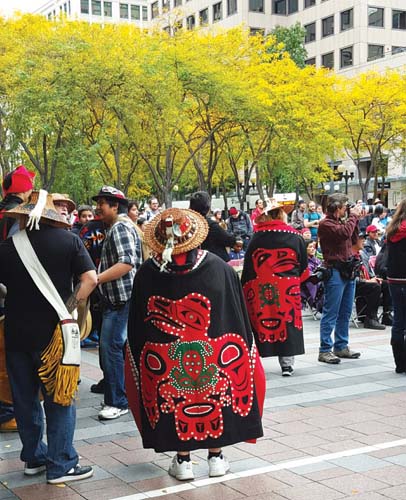
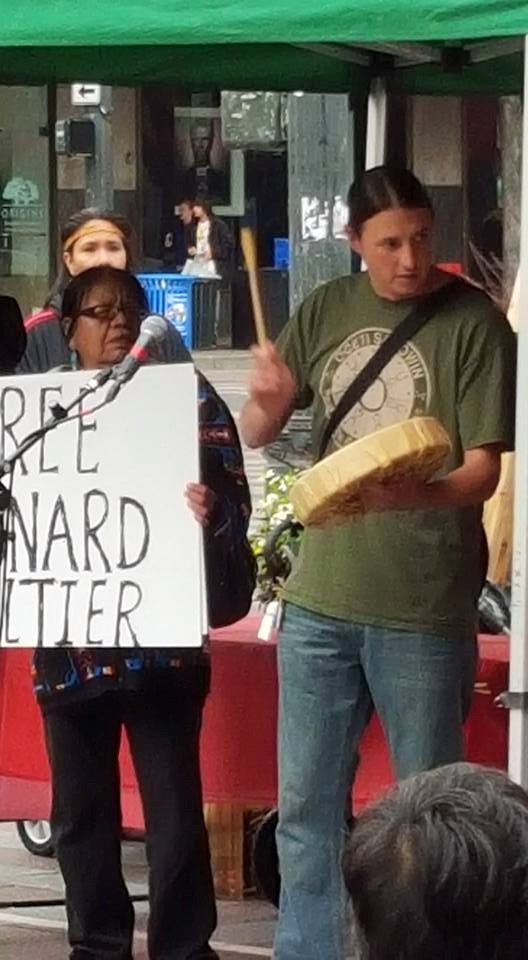
The celebration was comprised of three main events, to which any and all Native community members and supporters were freely invited to. The first event was a celebratory march from Westlake Park in downtown Seattle. Hundreds of people gathered at Westlake Park, most decked out in their Native regalia, and they beat their drums and sang as loud as they could while marching to their Seattle City Hall destination.
The second event took place in the Bertha Knight Landes room of Seattle City Hall, where Indigenous Peoples’ Day celebrators were greeted by the Seattle Mayor and Seattle City Councilmembers.
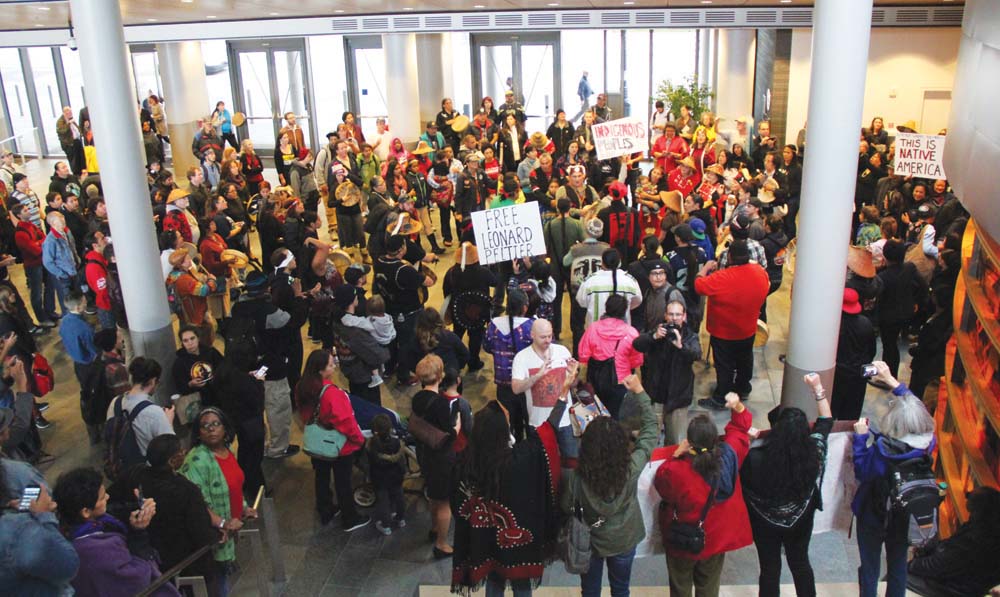
“Last year we took a historic step in the city of Seattle, and today it is an honor to be here and be with all of you to celebrate the 1st anniversary of Indigenous Peoples’ Day,” said Seattle Mayor Edward Murray. “It marks a new history in the city of Seattle and continues our dialogue with the tens of thousands of Native Americans who call Seattle home. It goes without saying that the history of this city is intertwined with the history of our Native peoples. We know we face challenges with the institutional discrimination that remains today, in housing, addiction and education. We will continue to work on these issues in Native communities. If anywhere in the nation we can make progress on these very challenging issues, it’s us. We have an incredible heritage of tribal communities who have been groundbreaking and leading this state long before my ancestors were here. Going forward, we have a lot of healing to do, but today we are here to celebrate. Today we are here to honor. Today we are here to say Indigenous Peoples’ Day is more than just a day, it’s every day.”
Lunch, consisting of salmon chowder, frybread, and a healthy fruit salad, was served to all those in attendance.
Following lunch, a very passionate, keynote speech was given by Winona LaDuke. She is a member of the Anishinaabe nation from the White Earth Reservation in Minnesota and is renowned for her activism on behalf of indigenous people and the environment. She is also a two-time Green Party vice presidential candidate.
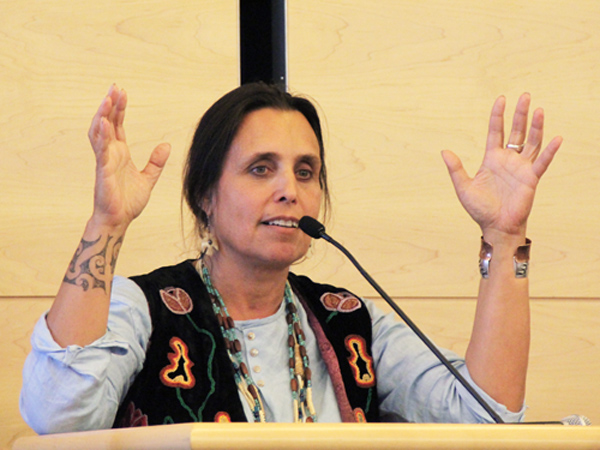
“What a great day it is. It is so happy, so liberating,” marveled LaDuke. “On our march here I noticed ‘Columbus Day Sale’ signs in the windows of some stores, and I was thinking does that mean I can walk around those stores and take whatever I want?”
“It is so liberating for me to be here and celebrate with you all in just how awesome it is be Indigenous people. You know, it’s always perplexed me how someone can name something as large as a mountain or sea or an entire day after someone as small as a human. It changes how people view things when everything is named after all these white guys. We are just beginning. There is a lot of work ahead in the renaming and recovering and restoration of our homelands. In doing so we remember our ancestors. In doing this we honor all those before us, all those here, and all those yet to come. And we reaffirm our place here as a people who remember, as a people who do not suffer from historic amnesia. We are a people who live today in a civil society who knows where it is exactly and is willing to be healthy, healthy and beautiful.”
“We are living proof that it is possible to live in a worldview that does not include empire, the destruction of our Mother Earth, and being ran by the morally corrupt oil and pharmaceutical companies,” continued LaDuke to a crown of cheering Native community members and supporters. “As we open our minds here I’m really honored to be with you in Seattle, a place that is in process of deconstructing the colonial renaming of our mountains, rivers, and oceans. I have great admiration and respect to y’all out here for standing up in what you know is true and being here to celebrate this great day.”
There was an evening celebration held at the Daybreak Star Indian Cultural Center that consisted in Native and Indigenous people from all over the nation performing their cultural songs and dances, not entertainment, but to celebrate each other. Celebration in recognition of a day that not only provides us with a platform to raise awareness, but it also commemorates a history of survival and perseverance.
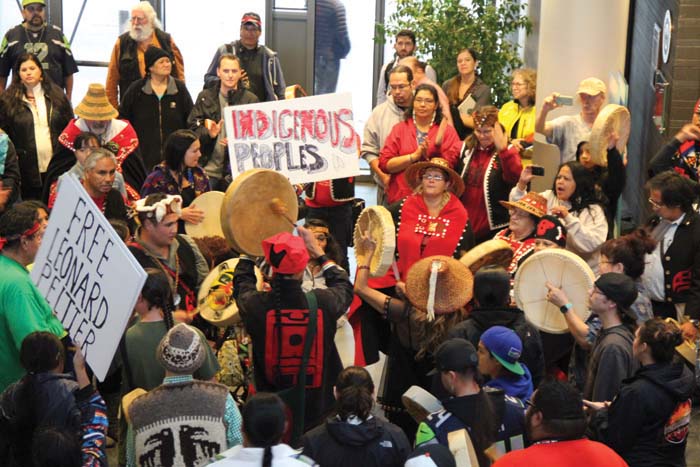
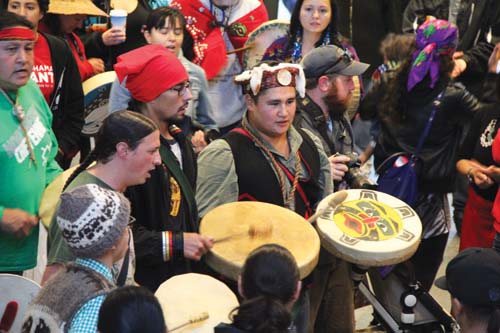
by Micheal Rios, Tulalip News
On Friday, October 9, the Tulalip Heritage Lady Hawks (3-4) volleyball team traveled to Lopez Island to take on the (5-1) Lobos. It was the second time these two teams have faced each other, with the previous being a 0-3 loss at home for Tulalip.
This time around the Lady Hawks had their full squad of players and have been playing very good team volleyball. The Lady Hawks were able to keep the score close in each game, countering each Lobos point with a point of their own. Surprisingly, two of the three games were played beyond the 25 point mark because neither team was able to take a two-point advantage. Unfortunately, even with the great effort being displayed by the Lady Hawks they would fall just short in both of those games.
The Lobos won the match 3-0 over the visiting team, but Tulalip gave them all they could handle and if only a couple points had gone differently they could have won the match.
On Tuesday, October 13, the Lady Hawks (3-5) again hit the road and traveled the short distance to Cascade Christian Reformed Church in Marysville to play the Arlington Highland Knights (4-4). It was also the second time these two teams had faced each other, with the previous being a very competitive 0-3 defeat at home for Tulalip.
This match would have substantial repercussions on the Northwest 1B volleyball standings. Currently sitting in the #4 spot are the Knights and only one game behind them are the Lady Hawks at #5. With a win the Lady Hawks could have the inside track to being the #4 seed come playoff time, meaning they would host a home playoff game.
Prior to the game, coach Tina Brown spoke about the team’s mindset heading into this big matchup. “We’ve been working hard in practice and going over game film to have the girls see what areas of their game needs improvement. They agree communication is our number one area to focus on. Our communication has been the biggest factor in our wins and in our losses. If we focus on communicating and helping each other out, then this will be a great game. We have to communicate and trust each other.”
In the 1st game, everything that could go wrong for the Lady Hawks did go wrong. Early season struggles of hitting their serves in play was once again an issue. The Lady Hawks were giving away easy points to their opponent simply because they weren’t getting the ball over the net on their serves. As this continued to happen in the first game, the team really struggled to play together and they stopped communicating. The Knights went on to win the 1st game 25-13, in large part to the 7 unforced errors the Lady Hawks committed in their serving game.
In the 2nd game, the Lady Hawks cleaned up their service game and only committed 3 unforced errors. Getting the ball over the net got the girls engaged into the game and they communicated like they know how. Tying the game at 10-10 and then again at 20-20, the Lady Hawks were in good position to win the game. However, the Knights called timeout after the game was tied at 20-20 to talk things over. Their coach noticed the Tulalip front line players were moving way too close to the net, resulting in holes in the back line of the Tulalip defense. Out of their timeout, the Knights were able to capitalize on their coach’s advice and went on a 5-2 run to seal the game 25-22 by aiming for those holes in Tulalip’s back line.
In the 3rd game, the Lady Hawks started out hot and led by Adiya Jones serving four straight aces, took a 8-4 lead. The game was highly competitive and the Lady Hawks were playing their best ball of the match. After only giving up two points on bad serves, they were able to take a 23-18 lead. For whatever reason though, the Lady Hawks tightened up only needing a couple points to win the game and they stopped communicating with each other. Going back to what their coach said prior to the game, if they don’t communicate and trust each then they won’t be able to pull out a victory. And that’s exactly what happened. The Lady Hawks blew their 23-18 lead and lost the game 25-27, resulting in a 0-3 match defeat.
Both matches of this road trip were winnable by the Lady Hawks if they could just learn to communicate effectively for an entire match, not just for minutes at a time, and close out the games they are leading. Now sitting at 3-6 on the season, the playoffs are still a realistic goal, but only if the Lady Hawks clean up their game.
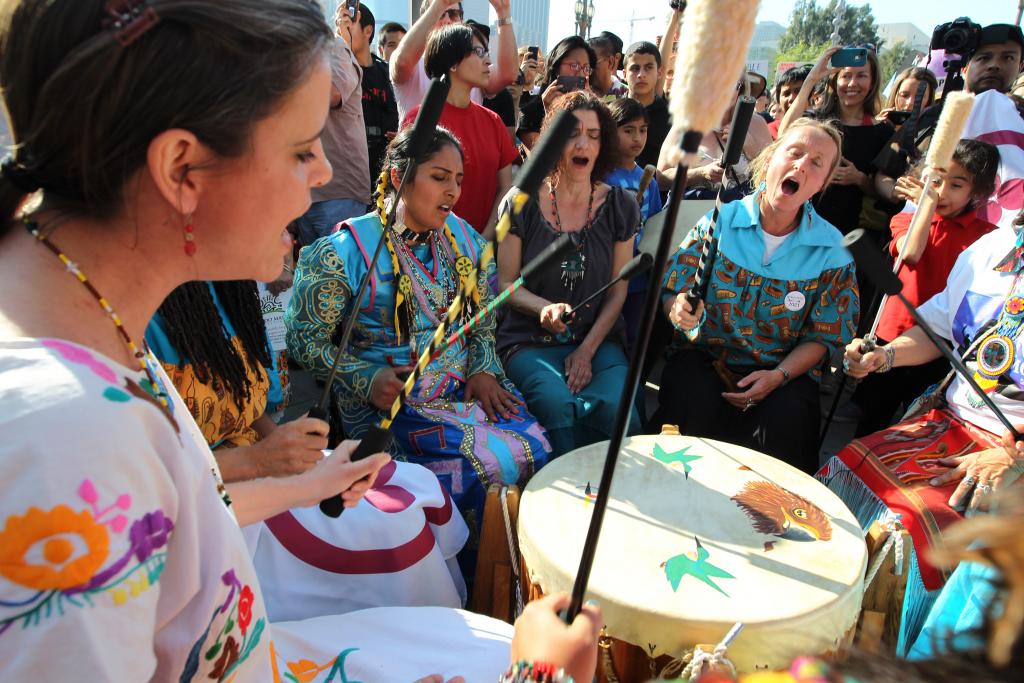
By Justine Calma, Global Post
NEW YORK — Not far from the negotiations for a new global development agenda that took place between heads of state at the United Nations General Assembly last month, a small group of female leaders gathered out of the limelight to sign another historic agreement.
The delegation chose not to meet at UN headquarters in east Midtown but on a traditional Native American tribal territory in Central Park’s East Meadow.
Seven women representing eight different tribes signed a treaty to unite the indigenous women of the Americas in friendship to protect the land and people from the harms of climate change and environmental degradation.
In what organizers said was the first-ever indigenous women’s treaty, the women pledged to support the rights of indigenous peoples, commit nonviolent acts of civil disobedience to protect the planet, and demand immediate changes to laws that have led to environmental destruction.
“We’re saying this is the line. We’re done. The destruction stops now,” said Pennie Opal Plant, one of the treaty’s lead signers.
The United Nations recognizes that women are more vulnerable to the effects of climate change because they constitute a majority of the world’s poor and are more dependent on natural resources for their livelihood.
“Women’s role as central stakeholders is one of the most important, yet untold stories of climate change. If we are to have a fighting chance at restoring the health of the Earth and our communities, women’s experiences and knowledge must be brought to the forefront,” said Osprey Orielle Lake, the executive director of Women’s Earth and Climate Action Network (WECAN), at an event where the treaty was later presented.
The signed treaty contends that the laws of Mother Earth “have been violated to such an extreme degree that the sacred system of life is now threatened and does not have the capacity for life to continue safely in the way in which it has existed.”
Opal Plant, who is of the Yaqui, Choctaw and Cherokee tribes, was instrumental in shaping the treaty. She grew up in the shadow of Chevron and Shell refineries in the eastern part of the San Francisco Bay Area, where she saw environmental degradation first-hand. She has organized nonviolent prayer walks in her home city led by Native American elders, but after connecting with other women during a gathering of nature rights advocates in Ecuador 2014, Opal Plant saw opportunity to launch a worldwide movement. She joined several other indigenous leaders from the US and Ecuador — Casey Camp-Horinek of the Ponca tribe, Patricia Gualinga Montalvo and Blanca Chancoso of the Kichwa, and Gloria Hilda Ushigua Santi of the Sápara.
“When women unite and commit to something, shifts happen,” said Montalvo, speaking through an interpreter. “I feel strongly that it’s a time to be heard and for actions to take place.”
Montalvo played a large role in successfully fighting the Ecuadorian government in 2012 in a landmark Inter-American Court of Human Rights case, Sarayaku v. Ecuador, in which the Ecuadorian government was found guilty of rights violations after authorizing oil exploration on Sarayaku lands without prior consultation with the indigenous community.
Opal Plant and her treaty co-signers presented their document at an event hosted by WECAN on Sept. 29, a Global Women’s Climate Justice Day of Action.
Women are disproportionately impacted by climate change, and they are central to solutions, said Orielle Lake at the event.
In the coming months, Opal Plant and her co-signers will create a website to expand the treaty beyond the Americas and allow other groups to sign online. In December, they plan to bring the treaty to COP21, the Paris Climate Conference, and hold another ceremony where more indigenous women leaders will join.
Montalvo’s indigenous community in Sarayaku is constructing a canoe that will travel from Ecuador to France. “The canoe is a symbol of Sarayaku, a symbol of our living forest,” said Montalvo. “We will bring it all the way to Paris so it can navigate the River Seine and so we will be heard.”
In New York, WECAN also presented a Women’s Climate Declaration, which includes a demand to bring back atmospheric carbon dioxide concentrations to below 350 parts per million — which many scientists agree is a level that avoids catastrophic global warming — and an aim to ensure that women’s groups have access to funding to adapt to climate change that is already happening. The declaration already has garnered over 2 million signatures and will be delivered at COP21 later this year.
Women comprise 20 million of the 26 million people estimated to have been displaced by climate change, according to a 2010 report by the Women’s Environmental Network.
“I ask that as temperature rises, that we rise,” said Orielle Lake.
by Micheal Rios, Tulalip News
Coming off their first win of the season, a 78-48 victory over Crescent High School, the Tulalip Heritage Hawks (1-3) were looking forward to a competitive game against one of their rivals, the Neah Bay Red Devils (3-0). The Red Devils are the back-to-back WA State 1B champions, currently ranked #32 in the nation, and ranked #1 in the state. The Red Devils have been destroying teams by an average margin of 37 points per game and appear prime to repeat again as 1B champions.
The game was played at Quil Ceda stadium on Saturday, October 10, where clouds opened up to rain showers just before kick-off.
On the opening kick-off the Red Devils scored on an 87-yard kick return, completed the 2-point conversions, and took an 8-0 lead over Tulalip Heritage less than 15 seconds into the game. On the Hawks ensuing possession they went 3 and out, but their 4th down punt attempt went awry as the snap was low and the ball was fumbled. The Red Devils took over on downs at the Hawks 22-yard line and on 1st down scored an easy touchdown to take a 14-0 lead.
It would be that kind of day for the Hawks, as the Red Devils were just too good, took advantage of every Hawks miscue, and continued to pile on the points.
Down 0-44 with 90 seconds left in the 1st quarter the Hawks got on the board. From their own 45-yard line, quarterback Willy Enick dropped back and connected to Robert Miles on a 15-yard throw. Miles shed a would-be tackler and was off to the races for a 55-yard touchdown.
The Red Devils would add another touchdown right before the end of the 1st quarter, giving them a 50-6 lead over the home team after the opening quarter.
Early in the 2nd quarter Willy Enick again connected with wide receiver Robert Miles for a 74-yard catch and run touchdown for the Hawks. This time it was a well-timed throw by Enick that caught Miles in stride and led him past the Red Devils secondary for the score. The 12-50 score was the closest the Hawks would get unfortunately.
The Hawks would be held scoreless for the remainder of the game and would go on to lose 12-72. It was definitely a humbling experience for the home team who with the loss now sit at 1-4 on the season. Next up is an away game at Clallam Bay on Friday, October 23.
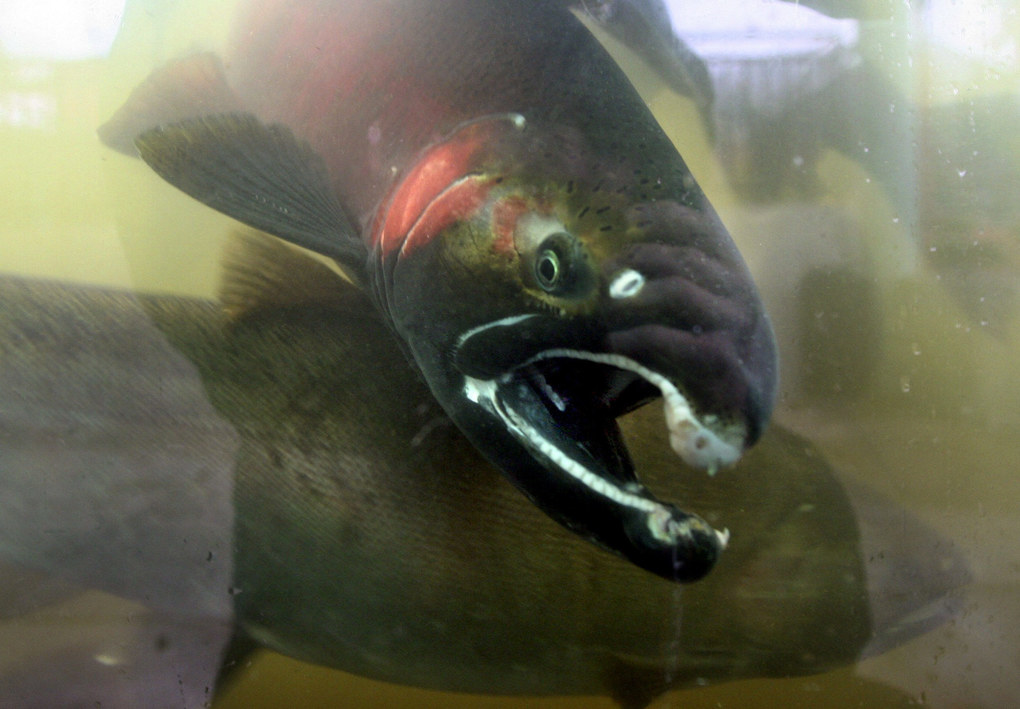
A new study shows that stormwater runoff from urban roadways is so toxic to coho salmon that it can kill adult fish in as little as 2½ hours.
But the research by Seattle scientists also points to a relatively easy fix: Filtration through a simple, soil-based system.
“It’s basically … letting the Earth do what it does so well, what it has done for eons: cleaning things up,” said Julann Spromberg, a toxicologist for the National Oceanic and Atmospheric Administration and co-author of the report published Thursday in the Journal of Applied Ecology.
Scientists have long suspected that the mixture of oil, heavy metals and grime that washes off highways and roads can be poisonous to coho, but the study is the first to prove it.
The research got its start more than a decade ago, when habitat-restoration projects began coaxing a trickle of coho back to several urban streams in the Puget Sound area. But many of those fish died before they could spawn. And the deaths seemed to coincide with rainstorms that sent runoff surging through drainage pipes and into the waterways.
In some place, like Longfellow Creek in West Seattle’s Delridge area, up to 90 percent of females were killed.
“It was apparent that something coming out of those pipes was causing it,” Spromberg said.
She and her colleagues tried to reproduce the effect in the lab. But the artificial mixture of oil and other chemicals they concocted had no effect on the fish.
So their next step was to try the real thing: Actual runoff, collected at NOAA’s Northwest Fisheries Science Centerfrom a downspout that drains a Highway 520 onramp near Montlake.
“When we brought out the real urban runoff: Bang! They were down, they were sick, they were dead,” said co-author Jenifer McIntyre, a researcher at Washington State University’s Puyallup Research and Extension Center.
In experiments at the Suquamish tribal hatchery near Poulsbo, every coho exposed to the runoff died — some within a few hours, all within a day. Before death, the fish became lethargic, rolled around and swam to the surface as if gulping for air, McIntrye said.
The fact that actual runoff proved fatal while the scientists’ concoction did not underscores an unsolved mystery about which chemical or combination of chemicals are so toxic to the fish. It could be any number of compounds that weren’t part of the artificial brew, including byproducts of oil and gasoline combustion, chemicals released by tires or tiny particles from brake linings, Spromberg said.
But whatever the chemical culprit, the scientists found it could be removed by passing the runoff through 55-gallon drums packed with layers of gravel, soil and compost. None of the fish exposed to the filtered stormwater died or fell ill.
“It was remarkable,” McIntyre said.
State regulations strongly encourage developments to use such approaches, according to the Washington Department of Ecology. A project called 12,000 Rain Gardens in Puget Sound is also promoting their use.
“We should be seeing more and more of these systems in the future,” McIntyre said.
Coho, which were once abundant throughout the Northwest, may be particularly vulnerable to toxic runoff because they spawn in the fall, prompted by seasonal rains. Habitat destruction, fishing and other factors almost certainly contributed to the species’ precipitous decline, Spromberg said.
Chum salmon, whose habitat and spawning seasons overlap those of coho in many places, don’t appear to be as affected by runoff — something the scientists plan to investigate this fall.
Perhaps the major limitation of the study is the small sample size. Only 60 coho were used in the experiments, 20 in each of two experimental and one control groups. The scientists were lucky to get that many, thanks to the cooperation of the Suquamish Tribe, McIntryre said.
Also, the urban runoff collected near Montlake was undiluted in the experiments and represents about the worst possible case: runoff from a busy highway in a big city, a DOE official who was not involved in the study pointed out.
“It’s great that the treatment gets rid of toxicity from this nasty stuff,” Karen Dinicola of DOE’s stormwater program wrote in an email. But it’s particularly challenging to retrofit urban-collection systems with greener alternatives, she said.
But the results of the research could help guide future development in rural watersheds where coho runs remain, the researchers said. And it can also be used to help inform urban-restoration projects as well, so fish aren’t lured back to appealing habitats, only to be clobbered by toxic runoff.
The researchers are preparing for their next round of studies, which will include tests to zero in on what is actually killing the coho.
The rain that soaked the region Wednesday also filled their runoff-collection barrels, Spromberg said.
“We only have one shot a year, when the fish come back and we can do the experiments and take the samples,” she said. “Hopefully, with this rain we’ll have more fish coming in soon.”